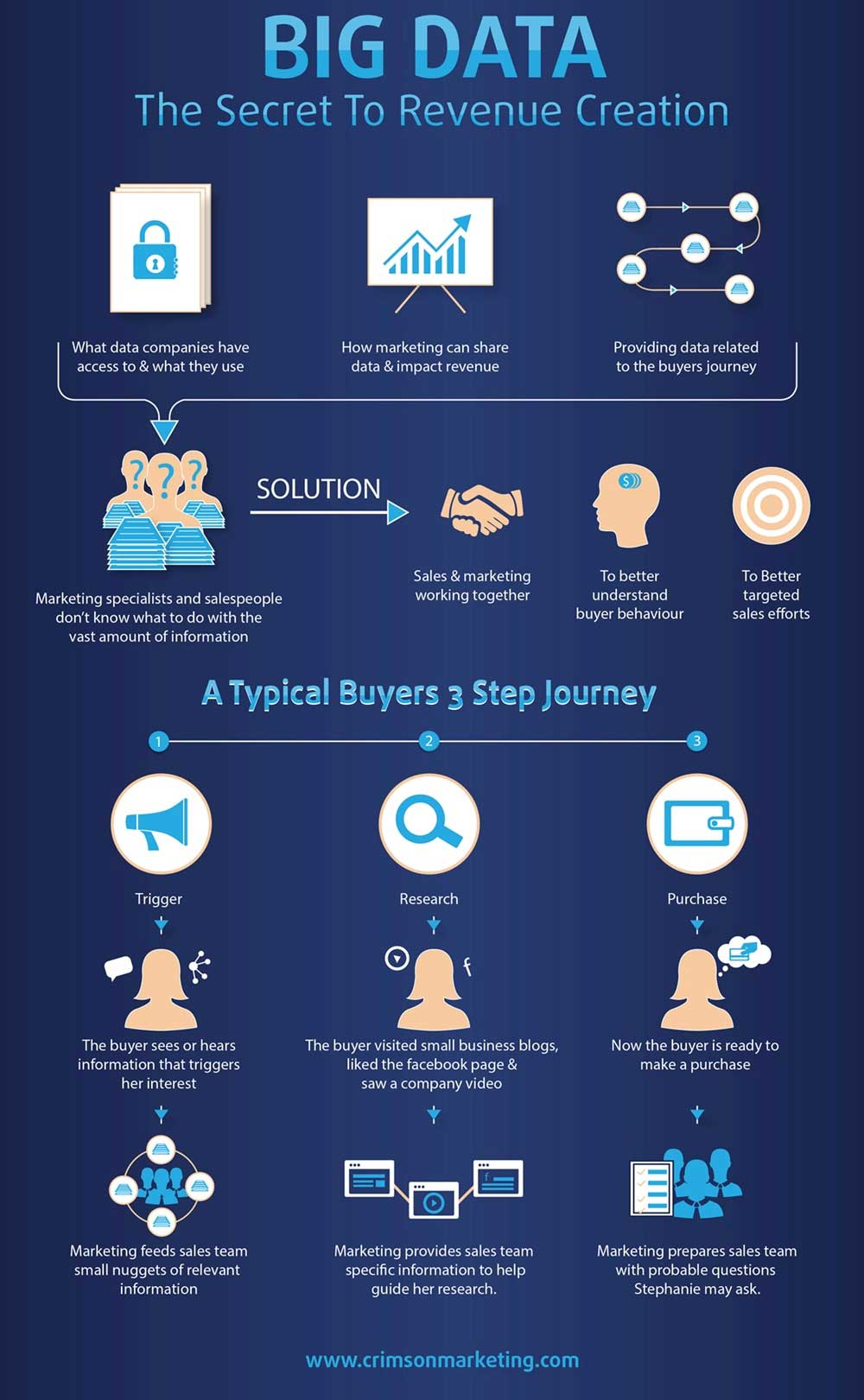Although we now have more valuable data about buyers than ever before, only 12% of organizations are putting that information—Big Data—into play.
Big Data has become a major buzzword, but many marketing specialists and salespeople still don't know what to do with the vast amount of information we have access to.
And the companies that are using it often do so in a disjointed manner: Marketing gets the data but doesn't know what to do with it; the focus of Sales is on small, specific data, and so it would be overwhelmed with such a vast amount of information.
It's rare that the two departments work together to benefit from shared information.
Working Together Nets Better Results
Before we look at all the ways that collaboration vis-à-vis Big Data by Sales and Marketing can help an organization, let's first look at the reality for most companies.
Marketing collects and manages data in a variety of systems, and it is effective with one or two of those systems (usually CRM and Web analytics). Sales zeroes in on turning leads into customers but has no time whatsoever to analyze data. Marketing has much more data than it can harness, and Sales doesn't get enough nuggets from Marketing to turn leads into customers.
It turns out that spending some time with that data can hugely pay off. In fact, companies using Big Data and analytics register an increase of 5-6% in productivity and profitability over their peers. Although diving into Big Data is a large time investment, it can cut down on the energy that Sales and Marketing put into chasing the wrong leads, and so increases the bottom line as a result.
When Sales and Marketing work together, interesting things happen. They begin to better understand buyer behavior, which enables the two teams to execute much better marketing campaigns, followed up with better-targeted sales efforts. They can create a tailored integrated marketing campaign based on where a buyer is in the purchase lifecycle. And, of course, the two departments can coordinate efforts to close more sales.
Where Social and Online Fit In
Your sales team is wasting a lot of time if it's not paying attention to what buyers are doing online. Let's use an example of Stephanie who works for a company that needs cloud computing solutions. She's the decision-maker.
A typical buyer goes through three steps in the buyer's Journey:
- The Trigger step is where buyers become aware of the problem and the solution.
- The Research step is where they actively conduct research to learn as much as they can.
- The Purchase step is where they are ready to make a purchase decision and want to engage with the sales organization.
The Trigger Step
The Trigger step is where something that Stephanie sees or hears triggers her interest in a solution. To help Stephanie move into this stage, Marketing can feed the sales team with nuggets of information that have triggered other buyers into looking at a cloud computing solution. Then, Sales can share those nuggets with social networks (while Marketing is doing the same via a broader effort).
Examples of nuggets of information for the Trigger step:
- A third-party report on trends in cloud computing
- A blog post detailing a success story
- An article discussing the benefits of cloud computing
The Research Step
Once Stephanie is triggered to look for a solution, she moves into the Research step. If you collect data on Stephanie, you see that she has clicked a few ads for cloud computing and visited those websites. She has searched on Twitter for advice about which cloud software users like. She's visited small business blogs and even downloaded an e-book titled "How to Choose the Best Cloud Platform for Your Business." She's liked your software company's Facebook page and shared some of your content with her followers.
The key contribution that Marketing can make to the sales team is to help them provide Stephanie (and people like Stephanie) with information to help guide her research.
Examples of information for the Research step:
- A third-party article about how your company has been increasing market share
- An announcement about a company thought leader speaking at a conference
- Information about how well your solution stacks up against competitors
The Purchase Step
Finally, when she's ready to buy, she enters the Purchase step. At this point, Stephanie has completed much of the buyer's Journey without talking to any salespeople. She has done most of the work online and by talking to peers and analysts. When she is ready to purchase, she needs to confirm or deny her belief that your solution is the right one for her.
The key contribution that Marketing can make to the sales team is to help them know what Stephanie is probably thinking at this point, and to prepare them for that conversation.
Examples of information for the Purchase step:
- Negative perceptions of our solution that Stephanie has been exposed to, along with a rebuttal
- Common misperceptions that might slow her decision-making process, and ways to alleviate those misperceptions
- Positive information that the sales team should emphasize
Marketing has data about buyers—sometimes more data than it knows how to handle. There's no reason to fear Big Data. It's just a matter of getting a handle on which information is the most beneficial for marketing activities, and which is most helpful to the sales organization. By working closely with Sales, Marketing can make a significant contribution to revenue.





